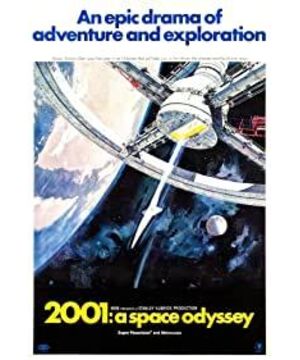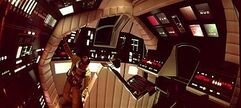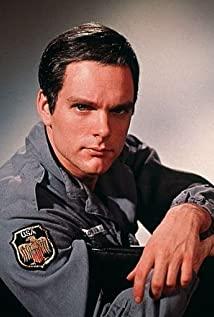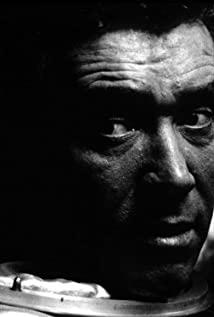"2001: A Space Odyssey"-this space "Odyssey" epic-is one of the most "ontological" films in my short history of personal viewing. The so-called ontology, it is a certain The ultimate essence in this universal form is a kind of questioning "...what is it?" In the context of this film, Kubrick is asking and discussing the ontological question: What is man? What is civilization? And the future direction derived from these two questions: mankind What is the end of civilization?
It is undoubtedly quite difficult to answer such questions. From the perspective of the history of philosophy, most ontological philosophers have encountered such theoretical barriers: what Kant calls "antinomies" at the epistemological level, or what Nietzsche calls "the collapse of the super-perceptual world." Fortunately, ontology is not Heidegger's "basic ontology", because ontology has a set of established questioning methods (that is, "what is...?" mentioned in the previous article). In Heidegger's sense, ontology is a "problem", but it has not yet risen to a more essential "difficult" level. This also means that although ontology is mostly difficult and unresolved, we can still find an effective way to "write" ontological issues. In other words, for serious and profound artists, the possibility of "writing" creates more openness of "expression". Stanley Kubrick is such an artist. He used the language of movies to write us the ontological picture of human civilization.
First of all, let us focus on the question of the film language itself, that is, what film form did Kubrick use to develop his ontology? In addition to the movie special effects technology that has been amazed by countless people (all those pictures: spacecraft, universe, space crossing, artificial intelligence...have become moments in movie history), I also pay attention to three points: Sound, literature and cosmic environment.
The sound especially refers to the movie soundtrack (OST) and some effect sounds. One of the biggest differences between "2001: A Space Odyssey" and most movies is that sound occupies a more dominant position in the relationship between sound and picture. Movies are usually regarded as "visual art", and the use of montage is more of a choice based on visual relationships (Eisenstein had a strong opposition to sound films). As a latecomer, sound is often regarded as an enhancement element attached to the visual picture. However, Kubrick not only amplifies the "effect" of sound in this film, but also changes the position of sound in the sound-picture relationship in the sense of approximate ontology (film ontology). This is clearly manifested in at least two places: first, the long black scenes of the film’s two appearances, only the film’s soundtrack is "informing" the audience: the film is still in progress; second, the editing point of the film is dominated by dubbing (not picture-oriented) ), once the soundtrack is over, the screen will be taken away by editing.
The literary nature of the film can be interpreted from many aspects, the most common one is from the perspective of "authorism". Of course, Kubrick is an outstanding film author within the Hollywood system. This is not only reflected in the film's "combination of director and director" creation method (the film is co-written by Kubrick and Arthur Clarke), but also It is reflected in the use of "using the camera as a fountain pen" (see Astruck's "Camera-fountain pen, the birth of a new avant-garde", 1948). One of the notable manifestations of the literary nature of the picture (that is, the “water pen” of the camera) is that in the part of “The Dawn of Man” and the part where David drives the auxiliary boat to travel through space, there are many different fixed large-vision lenses. Stop switching. Also generally speaking, the function of a big vision lens is usually a "fixed shot" or an "establishment shot", but in this movie, these big visions and their switching have lost the main fixed scene. The explanatory function has turned into a literary and simple description, and these big vision descriptions remind me of the environmental description passages in some existentialist novels (such as the "Unfaithful Woman" in Camus' "Exile and the Kingdom" The description of the desert in North Africa). All in all, these grand prospects, either realistic or sci-fi, have literary connotations that surpass ordinary fixed-point shots.
Regarding the cosmic environment, this is actually my association of Lacan-Zizek's symbolic and real worlds. The vast and unfathomable universe is the most typical real world, and it is the "protruding" part that we can hardly incorporate into it with any symbol system. In the film, we see such images from time to time: stars, planets, spaceships, meteorites, astronauts-they are all in the "dark" and "deep" cosmic environment. This has resulted in a very disruptive result that is also very subversive compared to the general movie: the location of the movie loses its environmental significance. All the exterior scenes are in the darkness of the universe, a deep invisible, we only see such and such objects (stars, planets, spaceships, meteorites, astronauts). As a result, the cosmic environment becomes "non-environment", because apart from various objects, we can hardly get any other meaning. This is Kubrick's third rewriting of the ontological level of film language—that is, film location.
Therefore, regarding the formal language of the film, we have temporarily concluded: in "2001: A Space Odyssey", Kubrick developed the ontological level of the formal language of the film itself in order to start writing the ontology of human civilization. Explore, transform and even subvert. Using the ontology of methodology (that is, film language) to "write" the ontology itself, Kubrick realized the "unity of knowledge and action" in a certain sense.
In the end, we return to the questions raised at the beginning: What is a person? What is civilization? And what is the end of human civilization? In "2001: A Space Odyssey", in Kubrick's writing, we may be able to snoop or grasp his answer.
The "dawn" of mankind is the scene of a group of orangutans living and living, which is quite ironic. But we have to admit that the daily activities of orangutans-eating and drinking, driving away, being preyed, fear, community, fighting (war)-are not much different from humans. What is even more noticeable is that orangutans will also form a kind of "religious worship" just like humans (or more accurately, humans will also be like orangutans). The object of worship is a hard black stele that suddenly appeared and did not know why. After some mysterious revelation, the orangutan was inspired by the black stele and used bones as a tool to liberate the front two feet. Paradoxically, tens of thousands of years later, mankind (now a highly developed technological civilization) also found a hard black stone stele on the moon, but also did not know why, and finally got some kind of revelation (the existence on Jupiter) With a wise life). From this, we have discovered the isomorphic relationship between "humanity at dawn" and "humanity after dawn": tools-bones and high-tech (spacecraft and artificial intelligence HAL 9000); inspiration-tool manufacturing and the Jupiter project; inspiration- —The same hard black stele that I don’t know why.
Obviously, the fulcrum of this isomorphic relationship is the black stele. The black stone stele has appeared three times in the whole film, and the first two times have appeared as the "revelation" of human civilization. So, what exactly is this black stele? My opinion is that it is nothing. Like the cosmic environment mentioned above, the black stone stele appears as a kind of "nothing". This "nothing" is relative to the symbolic world of humans. It cannot be attributed to the symbolic order and cannot be integrated into the symbolic reality (in fact, what we call "daily reality"). It is "highlighted" in the symbolic world of humans. A kind of "reality" outside, or to use Kant's theory, it is "things in themselves". However, perhaps absurdly or paradoxically, our symbolic world (that is, our human civilization) is built on this reality (that is, "primitive") that cannot be attributed to the symbolic world. The black stone stele (physical object) reveals this truth to human civilization (symbol world).
So, what does the third appearance of the Black Stone Tablet mean? When David finally arrived at the mission's destination, Jupiter, which is the so-called "intelligent creatures", what he found was only a human dwelling that combined classical and futuristic styles. There, there are only human beings themselves—human aging, human death, human disappearance, and human reincarnation (newborns). Another great irony has appeared: human beings have indeed discovered "intelligent creatures" in Jupiter, that is, human beings themselves, and they are constantly disappearing and aging themselves. At this time, the black stele appeared in front of the bed of the dying human being. The black stone stele at this moment is no longer used as the so-called "revelation of human civilization", but a mirror, showing a mirror image of the destination of human civilization. This mirror image is: Human civilization will eventually go to a kind of futile, a kind of unnecessary self-consumption and self-destruction. And this process will be a kind of reincarnation, which we can't save and cannot stop.
I think that, in fact, after the film ended, Kubrick also gave his answer to the question about the ontology of human civilization. Man is a creature that relies on the real thing (thing itself) to construct symbolic reality and symbolic imagination. Civilization is a kind of symbol order and symbol world constructed by human beings. And the end of human civilization is two: Either it will be backlashed by tools built with symbols (just like HAL 9000 kills human astronauts), or it will move towards a cycle of unnecessary consumption and unnecessary destruction. One of the two paths is taken. It can be said that Kubrick is quite pessimistic and hopeless towards people and human civilization. After all, all this is written from the level of ontology, and ontology itself presupposes or implies the existence of objective mechanism, and the so-called objectivity mostly includes a kind of fatalistic destiny.
This is one of the most ontological movies I have ever seen, and one of the best movies I have ever seen.
Top ten personal movies.
View more about 2001: A Space Odyssey reviews











